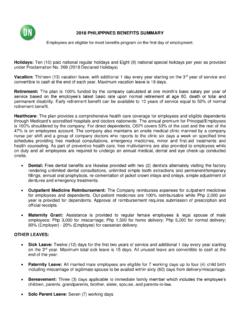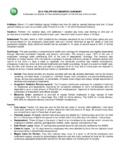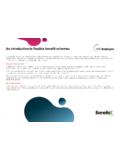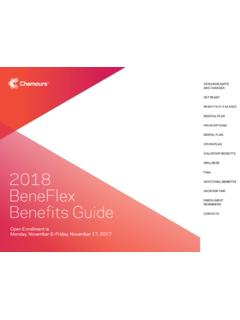Transcription of Complications Related to Percutaneous Endoscopic ...
1 Complications Related to Percutaneous Endoscopic gastrostomyJ Gastrointestin Liver DisDecember 2007 No 4, 407-418 Address for correspondence: , MDOPUS 12 Foundation304 Monroe BoulevardKing of Prussia, PA 10406, USAE-mail: Related to Percutaneous EndoscopicGastrostomy (PEG) Tubes. A Comprehensive Clinical ReviewSherwin P. Schrag1, Rohit Sharma2, Nikhil P. Jaik3, Mark J. Seamon4, John J. Lukaszczyk3, Niels D. Martin5, Brian ,6, S. Peter Stawicki71) Department of Surgery, Division of Trauma and Surgical Critical Care, Vanderbilt University Medical Center,Nashville, TN. 2) Department of Surgery, Easton Hospital, Easton.
2 3) Department of Surgery, St Luke s Hospital andHealth Network, Bethlehem. 4) Department of Surgery, Division of Trauma and Surgical Critical Care, Temple UniversitySchool of Medicine, Philadelphia. 5) Department of Surgery, Division of Traumatology and Surgical Critical Care,University of Pennsylvania School of Medicine, Philadelphia. 6) Department of Surgery, St Luke s Hospital and HealthNetwork, BethlehemSt. Luke s Trauma Center, Bethlehem. 7) OPUS 12 Foundation, King of Prussia, PA, USAA bstractPercutaneous Endoscopic gastrostomy (PEG) hasbecome the modality of choice for providing enteral accessto patients who require long-term enteral nutrition.
3 Althoughgenerally considered safe, PEG tube placement can beassociated with many potential Complications . This reviewdescribes a variety of PEG tube Related Complications aswell as strategies for complication avoidance. In addition,the reader is presented with a brief discussion of procedures,techniques, alternatives to PEG tubes, and Related topics covered in this review include PEG tubeplacement following previous surgery and PEG tube use wordsPercutaneous Endoscopic gastrostomy PEG Complications - endoscopy - managementIntroductionPercutaneous Endoscopic gastrostomy (PEG), themodality of choice for long-term enteral access, was firstdescribed in 1980 by Ponsky and Gauderer (1,2).
4 Severalmodifications of the original procedure have been described(3-6). Although generally safe, PEG tube placement isassociated with many potential Complications . To date, therehave been no comprehensive reviews of PEG tube relatedcomplications. In an attempt to fill this void, we present areview that describes the most commonly encountered PEGcomplications as well as strategies for their literature review was performed via the PubMedTMsearch engine from 1976 to 2007, using the search terms PEG tube , PEG , Complications , technique , and morbidity . Relevant cross-referenced non-PubMedTMlisted articles were also included.
5 Three hundred thirty-twoarticles were found including randomized controlled trials,retrospective studies, case series, case reports, editorials,letters and abstracts. These sources were evaluated forrelevance to current medical practices and goals of : indications and contraindicationsIndicationsPEG tubes have two main indications feeding accessand gut decompression (7). In patients who are unable tomaintain sufficient oral intake, PEG tubes provide long-termenteral access. This commonly includes patients withtemporary/chronic neurological dysfunction, includingthose with brain injuries, strokes, cerebral palsy,neuromuscular and metabolic disorders, and impairedswallowing.
6 Significant head/neck trauma and upperaerodigestive surgery that preclude oral nutrition alsoconstitute important indications. In patients with advancedabdominal malignancies causing chronic obstruction/ileus,a PEG tube can be used to decompress the intestinal tubes may also be useful in the setting of severe bowelmotility disorders (8).ContraindicationsAbsolute contraindications to PEG placement includepharyngeal or esophageal obstruction, active coagulopathyand any other general contraindication to endoscopy. Ofthe three principal safety tenets of PEG placement, Endoscopic gastric distension, endoscopically visible focalfinger invagination, and transillumination, only the latterhas been successfully challenged.
7 Stewart et al. placed 62 Schrag et al408 PEG tubes without transillumination and had a 97% successrate, with no immediate Complications , and two failuresunrelated to the technique used (9).The presence of oropharyngeal or esophageal cancer isa relative contraindication, due to the potential seeding ofthe PEG tract with cancer cells (10). Here, either aradiographically placed Percutaneous gastrostomy orsurgical gastrostomy tube may be more appropriate. In theface of esophageal cancer, PEG tubes are usually avoidedto preserve the gastric conduit for reconstruction , gastroesophageal reflux was considered acontraindication.
8 It is now known that gastroesophagealreflux may actually improve after PEG placement, as the PEGitself creates an anterior pseudo-gastropexy (11).Other relative contraindications include abdominal wallabnormalities such as the presence of prior abdominalsurgery, especially procedures involving the stomach, spleenor splenic flexure of the colon. While it is acceptable toattempt PEG placement in the face of prior surgery, oneshould have a low threshold to abort if the three safetytenets are absent. The presence of abdominal wallmetastases, open abdominal wounds, or ventral herniadefects all constitute relative contraindications.
9 Intra-abdominal contraindications include hepatomegaly,splenomegaly, and moderate or severe ascites. Portalhypertension with gastric varices also constitutes acontraindication to PEG placement. Systemic contra-indications include recent myocardial infarction,hemodynamic instability, coagulopathy, and knowledge and adherence to the proper techniquesof PEG placement is crucial to complication avoidance. Themost widely used PEG technique is the pull method (1-2).There are several modifications of the original gastrostomy tube can be pushed rather than pulledinto place by a push (Sacks-Vine) method (12). In the introducer (Russell) method, the stomach is directlypunctured and a Foley catheter placed over a gastrostomy has also been described withoutendoscopy, using a nasogastric tube for gastric insufflation,fluoroscopy, and a direct Percutaneous catheter insertion(6).
10 The most commonly used method of placement is thepull technique. After preparation of the abdomen,administration of prophylactic antibiotic and sedation/analgesia, a complete upper endoscopy is performed. Thestomach is insufflated, resulting in close apposition of thestomach to the abdominal wall. A point is chosen in the mid-epigastrium, where there is maximal transillumination andindentation of the gastric lumen, with direct pressure of ablunt pointer. A local anesthetic is then infiltrated into thearea around the puncture site and a small incision is made. Alarge-bore needle is inserted into the gastric lumen underendoscopic observation.








